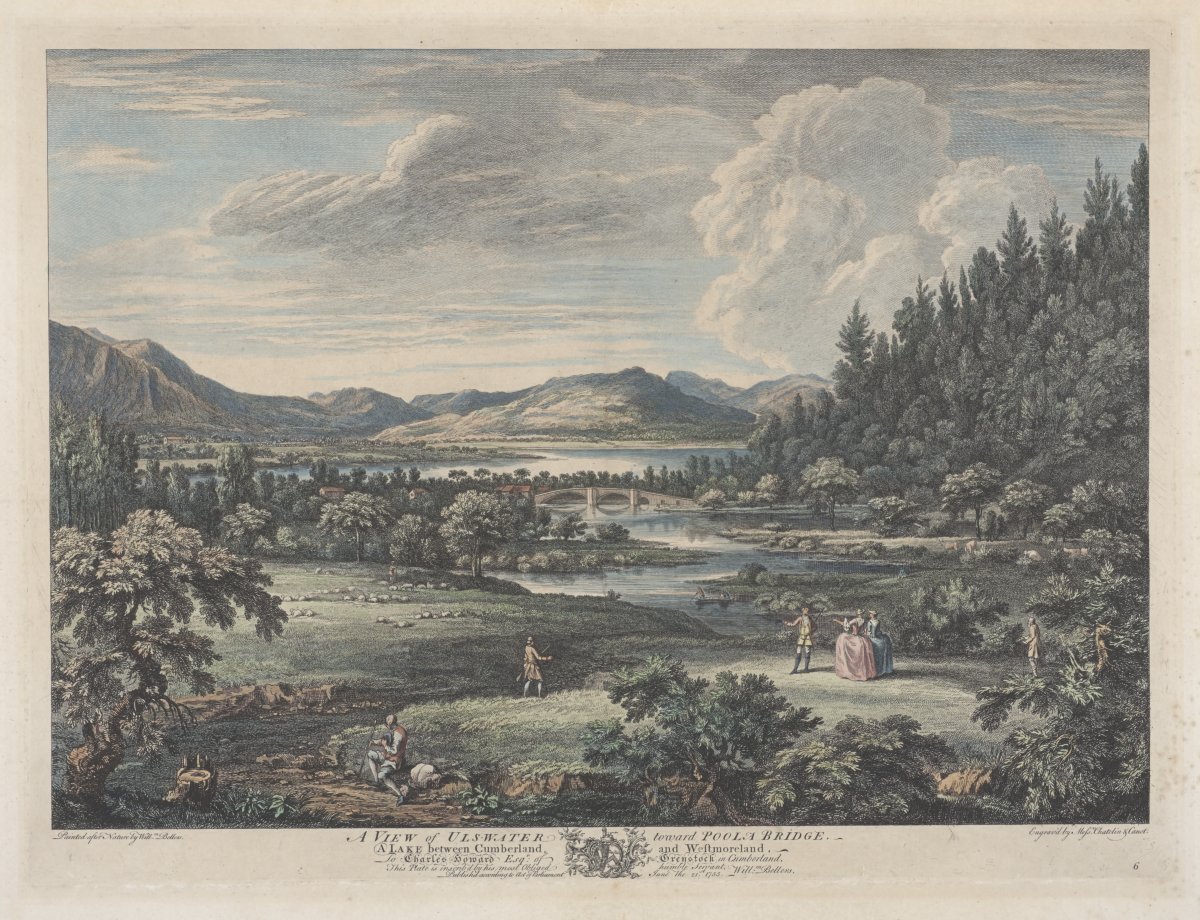A View of Ullswater toward Poola Bridge. A Lake between Cumberland and Westmoreland
William Bellers
Pierre Charles Canot (1710 - 1777)
Jean Baptiste Claude Chatelain (c.1710 - c.1771)
Coloured engraving
published 21 June 1753
-
About the work
- Location
-
Country: UK
City: London
Place: Government Art Collection
In the foreground of this Cumbrian landscape, fashionable women are seen walking with men holding guns. To the right is a wooded hill. A river spanned by a bridge winds towards the lake, surrounded by mountains, in the distance. This work was both drawn and published by artist William Bellers and is plate six of his series of eight engraved views of landscapes in northern England.
Ullswater is the second largest lake in the English Lake District and measures approximately 9 by ¾ of a mile. It is in the shape of a ‘Z’, with three separate ribbon-like sections surrounded by mountains and is commonly regarded as the most beautiful of English lakes.
Pooley [Poola] Bridge, near the edge of Ullswater Lake, spans the River Eamont just before it meets the northern end of the lake. The name of the bridge is derived from a large pool in the river, which once existed near the location of the bridge, but has now disappeared. The adjacent village of Pooley Bridge includes two main streets of old stone houses.
-
About the artist
Painter and engraver William Bellers is thought to have enrolled at the University of Oxford in 1734 as ‘illuminator’ (painter) and ‘privilegiatus’ (licensed to work within the university). He later mainly made views of the Lake District in the manner of George Lambert and also painted or etched views in Birmingham, Derbyshire, Hampshire, Sussex and along the English coast. He exhibited over 60 works at the Free Society of Artists (1761-73). The rights to his plates were purchased by Robert Sayer in c.1766 and then by John Boydell in c.1769. Boydell issued a series of eight prints in 1774. Bellers sold prints and drawings by himself and the Old Masters from his home in Poppins Court, off Fleet Street. Nothing is known of him after 1773.
Engraver Pierre [Peter] Charles Canot is thought to have been born in France in c.1710; the brother of painter Philippe Canot. He was presumably in London by c.1735, when he produced hunting prints after paintings by John Wootton. A further set of prints, after marine works painted by Peter Monamy, were published in 1746. In 1758 he began a lasting collaboration with marine artist Richard Paton. The outbreak of the Seven Years' War brought commissions for depictions of the many naval engagements. He exhibited 19 works at the Society of Artists from 1760 to 1769 and was elected one of the original associate engravers of the Royal Academy in 1770, exhibiting there until 1776. Canot died at his home in Hampstead Road, in the winter of 1777-78.
Draughtsman, etcher and line engraver Jean Baptiste Claude Chatelain (real name Phillipe) was a Frenchman, born in London. He fought at Flanders before specialising in landscape and topographical views. He made prints after works by 17th-century painters as well as contemporary artists, and also after his own drawings. Chatelain worked in London for the engraver and printseller John Boydell (1720-1804), for whom he engraved works by Claude and Poussin, and also English views. He produced some 50 views in and around London. Chatelain’s unique style of engraving and etching has led to his plates being described as both ‘lazy’ and as demonstrating ‘masterly wildness’.
-
Explore
- Places
- Subjects
- Materials & Techniques
-
Details
- Artist
-
William Bellers
Pierre Charles Canot (1710 - 1777)
Jean Baptiste Claude Chatelain (c.1710 - c.1771)
- Title
- A View of Ullswater toward Poola Bridge. A Lake between Cumberland and Westmoreland
- Date
- published 21 June 1753
- Medium
- Coloured engraving
- Acquisition
- Purchased from Frank T Sabin, August 1960
- GAC number
- 5339